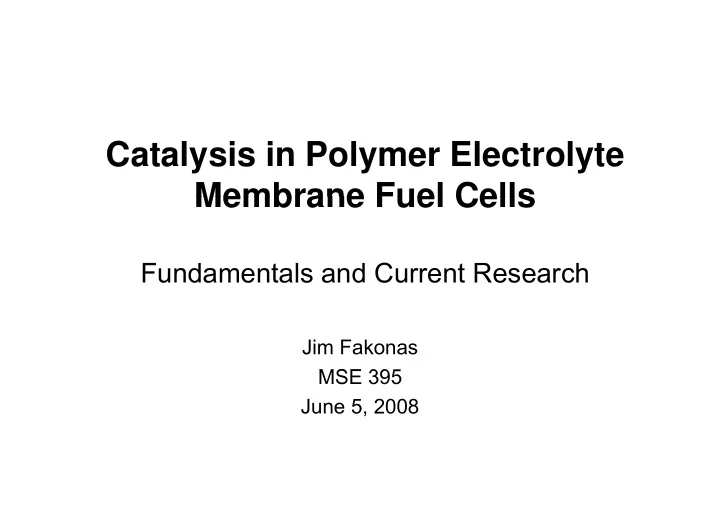

Catalysis in Polymer Electrolyte Membrane Fuel Cells Membrane Fuel Cells Fundamentals and Current Research Jim Fakonas MSE 395 MSE 395 June 5, 2008
Overview Part I: Fundamentals of Catalysis in Fuel Cells y Part II: Current PEMFC C t l Catalyst Research t R h The concepts in Part I are applicable to all fuel cells, while Part II concerns only PEMFCs.
Part I Part I Fundamentals of Catalysis in F Fuel Cells l C ll
Fuel Cell Structure e - Oxygen/air Hydrogen H + Cathode Anode Water vapor Electrolyte y Catalysts y A fuel cell separates two halves of an electro- chemical reaction to convert H 2 to electricity.
Case Study: Hydrogen Oxidation y y g + + − → H ads H e ( ) H / H + d , d R. O’Hayre et al. Fuel Cell Fundamentals. Hoboken, NJ: John Wiley & Sons 2006 pgs 237–240 NJ: John Wiley & Sons, 2006, pgs. 237 240. Reactants must overcome an energy barrier – the activation energy – to convert into products.
At Thermodynamic Equilibrium y q + − Δ ⎛ ⎞ G ∝ ⎜ ⎟ = j exp 0 0 ⎝ RT ⎝ ⎠ ⎠ RT R. O’Hayre et al. Fuel Cell Fundamentals. Hoboken, R. O Hayre et al. Fuel Cell Fundamentals. Hoboken, NJ: John Wiley & Sons, 2006, pgs. 237–240. The forward and reverse reaction rates eventually reach a dynamic equilibrium with current density j 0 .
Away from Equilibrium y q + ⎡ ⎡ α η ⎛ ⎛ ⎞ ⎞ nF F = − ⎜ ⎟ j j ⎢ exp 0 ⎝ ⎠ ⎣ RT = ( ( ) ) ⎤ ⎤ − − α nF η ⎛ ⎛ ⎞ ⎞ 1 1 F ⎜ ⎟ ⎥ exp ⎝ ⎠ ⎦ RT R. O’Hayre et al. Fuel Cell Fundamentals. Hoboken, R. O Hayre et al. Fuel Cell Fundamentals. Hoboken, NJ: John Wiley & Sons, 2006, pgs. 237–240. An activation overpotential, η , is necessary to produce a net current.
The Butler-Volmer Equation q ⎡ α η η ⎛ nF ⎛ ⎞ ⎞ = − ⎜ ⎜ ⎟ ⎟ j j j j ⎢ ⎢ exp 0 ⎝ ⎠ ⎣ RT ( ( ) ) − − α α nF η F η ⎤ ⎤ ⎛ ⎛ ⎞ ⎞ 1 1 ⎜ ⎟ exp ⎥ ⎝ ⎠ ⎦ RT R. O’Hayre et al. Fuel Cell Fundamentals. Hoboken, R. O Hayre et al. Fuel Cell Fundamentals. Hoboken, NJ: John Wiley & Sons, 2006, pgs. 237–240. Catalysts are necessary to maximize j 0 , allowing for operation at high current densities.
Part II Part II Current PEMFC Catalyst R Research h
PEMFC Catalyst Goals y Current PEMFCs use Pt catalysts which have two noteworthy problems: t th bl Cost – New PEMFC catalysts must New PEMFC catalysts must Cost use 4x less Pt* *U.S. Department of Energy . Hydrogen Posture Plan (2006), pg. 5. p gy y g ( ), pg Poisoning – Contaminants/electrolyte Contaminants/electrolyte Poisoning solution must not poison the catalyst. Most current PEMFC catalyst research focuses on modifying Pt catalysts to meet these goals.
Increasing Activity #1: Morphology g y p gy N. Tian, et al. Science 316 (2007) 732–735. Optimizing the size and shape of Pt nanoparticles increases their ethanol oxidation activity 4-5x.
Increasing Activity #2: Composition g y p Pt Cu Co R. Srivastava, et al. Angew. Chem. Int. Ed. 46 (2007) 8988–8991. Core-shell nanoparticles of Pt alloys increase their oxygen reduction activity 4x.
Reducing Poisoning #1: Morphology g g p gy ~3 nm polyhedra ~5 nm truncated cubes ~7 nm cubes C. Wang, et al. Angew. Chem. Int. Ed. 47 (2008) 3588–3591. The (100) facets of Pt nanocubes do not bond SO 4 2- as strongly, leaving more sites for O 2 oxidation.
Reducing Poisoning #2: Purification g g S. Alayoglu, et al. Nature Materials 7 (2008) 333–338. Ru-Pt core-shell nanoparticles effectively oxidize CO at suitable PEMFC operating temperatures.
Conclusions Part I: Fundamentals of Catalysis in FCs y • Catalysts decrease activation E • Essential for operating at high current densities Essential for operating at high current densities Part II: Current Research for PEMFCs Part II: Current Research for PEMFCs • Increase activity by: – Increasing surface density of reactive sites Increasing surface density of reactive sites – Modifying electronic structure near surface • Reduce poisoning by: • Reduce poisoning by: – Modifying catalyst surface – Purifying fuel – Purifying fuel
Recommend
More recommend